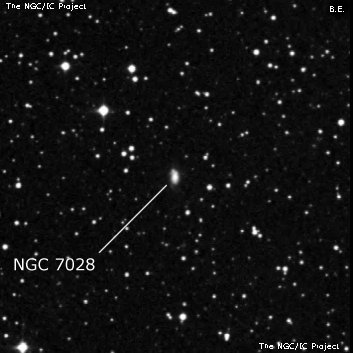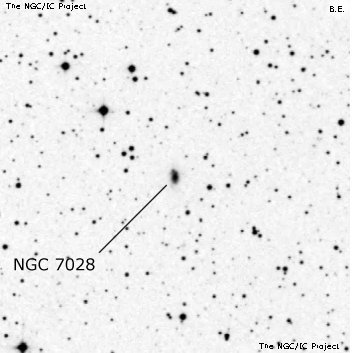NGC/IC Project Restoration Effort
(This is a very very beta version)
NGC7028


Basic Information
Location and Magnitude
Right Ascension: 21:8:15.0
Declination: +18:28:48
Constellation: DEL
Visual Magnitude:
Historic Information
Discoverer: Marth
Year of discovery: 1863
Discovery aperture: 48.0
Observational
Summary description: vF, S, vlE
Sub-type: NF
Corwin's Notes
=====
NGC 7028. This may be lost. There is certainly no nebula near Marth's place,
even though he claims to have verified the object. The closest candidate
object is a triple star well to the southwest. Since there is no large
systematic offset (in Marth's positions from the modern positions) for the
other four objects that he found the same night (N7025, N7033, N7034, and
N7056), I don't believe that the triple is Marth's object.
A possible candidate is CGCG 448-039. It matches Marth's scanty description
(very faint, small, very little extended), and the declination is the same,
but the RA is over 2.5 minutes of time off. However, the large non-digit
difference makes the identity difficult to accept, so I've put a question
mark on it in the main table.
-----
Looking at this again in April 2016, I'm even less convinced than before that
CGCG 448-039 is Marth's object. There are three other galaxies, all at
Marth's RA (within his usual uncertainty), two of which are extended.
However, looking at the field, I think that the triple star I noted earlier is
also a good candidate, so I have put it into the position table. The four
galaxies are there, too. Here are some notes on them:
CGCG 448-039 -- As I noted earlier, this matches Marth's description and
declination pretty well, but is 2.5 minutes of time off his RA.
CGCG 449-004 -- This, too, would match Marth's description and the RA
matches. But the Dec is about 40 arcminutes south of the nominal Dec.
CGCG 449-005 -- This is the brighter of a pair with 449-006. Again, the RA
fits, but the Dec is off by 17 arcminutes, and the galaxy is very nearly
exactly round.
CGCG 449-006 -- Here is another extended galaxy at more or less the right
RA. However, the Dec is again off by about 17 arcminutes and the galaxy
is fainter than its close companion 449-005; it has a lower mean surface
brightness as well. So, if this Marth's object, why did he not pick up
the brighter companion?
In the end, I see no really good candidates for this NGC entry. I slightly
favor the triple star, but it might be too bright to be mistaken for a nebula
at the eyepiece of a 48-inch reflector. Visual examination is needed.



